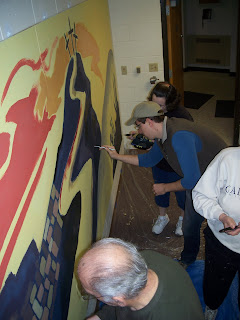The Path of Salvation
If you were to paint a picture of the path Christ took to save us, what would you include? Word of God, Davenport, recently tackled that idea. For the past several years in their worship room at Trinity, Davenport, one blank wall has been practically begging to be dressed up in a meaningful way. The members kicked around the idea of painting a mural, but did not have any concrete ideas of what subjects to include, nor the expertise to design or paint it.
That all changed when Rev. Karl Fay was called to Trinity in 2009. As an artist with prior experience designing large murals to be painted by teams of amateurs, he was exactly who the deaf needed to guide them through this project. The members and Rev. Tim Eckert, the district missionary to the deaf in Davenport, brainstormed ideas of what to include in the painting. Rev. Fay took those ideas and crafted them into a beautiful and workable design.
The frame-building and painting process took place over the course of four days spread out over several weeks. For everyone involved, it was a marvelous experience. Rev. Fay enjoyed getting to work with a population with whom he does not have frequent contact. The members of the deaf church had the pleasure of seeing a painting rich with symbols and colors come to life before their eyes. The whole deaf congregation is excited that this is now a permanent part of their worship experience.
Rev. Eckert delivered an 8-week sermon series through Lent and Easter which highlighted the major scenes in the painting.
- The city represents both the people needing salvation and also the incarnation of Christ. It was they who needed salvation and it was to them that Christ came. The city is both ancient and modern, for all people in all time are in need of salvation.
- The path is the whole life of Christ; His growing and maturing, teaching, miracles, a life of service. The path winds from the city to the cross and has a rich red component, because His ministry would be incomplete without His blood shed on the cross.
- Golgotha is both life and death. To us, it looks like a skull, a place of death, just as Moriah must have looked to Abraham as he journeyed there to sacrifice Isaac. But from God’s perspective, it is a place of life, because it was on that mountain that He provided the sacrifice for our sins and redeemed us.
- The meaning of the cross is central in the path of salvation. The path leads to the cross because the cross was the goal. The Son of Man came to give His life as a ransom for many.
- The significance of the empty tomb is also clear. The stone is rolled away, and a yellow glow from within the tomb shows that death was not the end for Christ and is not the end for us.
- A valley between Golgotha and the tomb serves as a reminder that even though Christ is risen, we still must go through a valley of the shadow of death. The good news, however, is that we do not go alone. Our Shepherd goes with us, and He has already seen death and conquered it. We have nothing to fear.
- A sunrise illuminates the sky in the background. For all who are in Christ, a new day has dawned. We now live in the light of Christ and can look forward someday to an even brighter morning.
- The final stage of the journey is a return to the city. Just as Christ came to redeem all people, so He sends us back into the world, into our daily lives wherever He has placed us, so that we can carry His life into the lives of the people around us.
To see a slideshow and several videos of the painting, please go to www.iowaeastdeaf.org and click on the “Mural in Davenport” link at the bottom of the page.
Photos
2751 Rev. Karl Fay sketching the outline to be painted.
2753 Ricky Moore, Larry Plumb, Neita Dommer, and Rachel Eckert painting the background.
2759 Larry Plumb and Ricky Moore demonstrate their excellent technique.
3072 The painting crew.
3080 Rev. Karl Fay instructs Neita Dommer on how to give the mountain texture.
3436 The final product.





